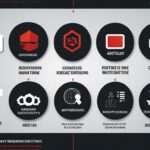.jpg)
Product management is a critical role that involves overseeing the development and success of a product from ideation to launch and beyond. It requires a unique set of skills and knowledge to effectively manage and drive product strategy. In a product management interview, candidates can expect a range of questions that assess their understanding of the role and their ability to handle various aspects of product development.
Some of the general questions that may be asked include:
1. What is your understanding of product management? This question aims to assess the candidate’s overall understanding of the role and its responsibilities.
2. Why do you want to pursue a career in product management? This question helps the interviewer gauge the candidate’s motivations and passion for the field.
3. How do you prioritize features or ideas? This question explores the candidate’s ability to make informed decisions and prioritize based on customer needs, market analysis, and business objectives.
In addition to general questions, technical questions may also be asked to evaluate a candidate’s technical knowledge and ability to execute product launches, gather customer feedback, and conduct user research. Product strategy questions may focus on the candidate’s approach to identifying target markets and successful product pivots. Product design and user experience questions may delve into the candidate’s process for creating intuitive user interfaces and handling conflicting feedback. Lastly, leadership and collaboration questions may assess the candidate’s ability to motivate cross-functional teams and manage competing priorities.
Preparing for a product management interview involves a thorough understanding of these key areas as well as the ability to articulate one’s experiences and insights effectively. By being well-prepared and knowledgeable, candidates can showcase their skills and stand out during the interview process.
Key takeaways:
Key takeaway:
- Understanding product management: Be prepared to explain your understanding of product management, including its role, responsibilities, and importance in the organization.
- Prioritizing features: Demonstrate your ability to prioritize features or ideas by considering factors such as customer needs, business goals, and market trends.
- Leadership and collaboration: Showcase your skills in motivating and inspiring cross-functional teams, as well as managing competing priorities effectively.
General Questions
During a product management interview, you can expect to be asked a variety of general questions that assess your knowledge and skills. These general questions are designed to evaluate your understanding of product management principles and your ability to apply them in different scenarios. Some common general questions include: “What is your approach to product discovery?”, “How do you prioritize features?”, and “How do you handle conflicting stakeholder requirements?” Answering these general questions thoughtfully and demonstrating your problem-solving abilities will showcase your expertise in product management.
1. What is your understanding of product management?
Product management is the process of strategizing, developing, and overseeing the creation of a product or service. A product manager is responsible for understanding customer needs, gathering market research, prioritizing features, and collaborating with cross-functional teams to bring the product to life. They also play a crucial role in product launch, gathering customer feedback, and making necessary pivots or improvements. Successful product managers possess strong leadership skills, are excellent communicators, and are able to navigate conflicting feedback from stakeholders. To illustrate the importance of product management, let’s look at the true story of Steve Jobs and the creation of the iPhone.
My understanding of product management is that it is the process of strategizing, developing, and overseeing the creation of a product or service. Product managers are responsible for understanding customer needs, gathering market research, prioritizing features, and collaborating with cross-functional teams to bring the product to life. They also have a crucial role in product launch, gathering customer feedback, and making necessary pivots or improvements. Successful product managers should possess strong leadership skills, be excellent communicators, and be able to navigate conflicting feedback from stakeholders. To further emphasize the importance of product management, let’s dive into the true story of Steve Jobs and the creation of the iPhone.
2. Why do you want to pursue a career in product management?
To pursue a career in product management, individuals are driven by a combination of passion for innovation, problem-solving, and the desire to make a meaningful impact. Product management offers a unique opportunity to work at the intersection of technology, business, and user experience. The role allows professionals to bring ideas to life, shape the direction of products, and influence the market.
Why do you want to pursue a career in product management? It requires a deep understanding of customer needs, strategic thinking, and effective collaboration with cross-functional teams. A real example that encapsulates the motivation behind pursuing product management could be a person’s experience of using a product that had a significant positive impact on their life or witnessing the transformative power of technology in solving societal challenges.
3. How do you prioritize features or ideas?
When prioritizing features or ideas in product management, consider factors such as customer needs, business goals, and technical feasibility.
- Customer needs: Conduct user research and gather feedback to understand what features are most important to customers.
- Business goals: Align feature prioritization with the overall strategic goals of the company.
- Technical feasibility: Assess the resources, time, and technical requirements needed to develop and implement each feature.
- Impact: Evaluate the potential impact each feature can have on improving user experience, increasing revenue, or achieving business objectives.
Suggestions:
- Establish a clear prioritization framework or scoring system to objectively evaluate and compare features.
- Regularly reassess and update the prioritization as customer needs and business priorities evolve.
- Involve key stakeholders, such as product managers, designers, engineers, and executives, in the prioritization process to ensure alignment and buy-in.
How do you prioritize features or ideas?
Technical Questions
During a product management interview, it is essential to come prepared for technical questions. These questions are designed to assess your technical expertise and your ability to apply it in practical scenarios. Examples of technical questions can cover topics such as database design, system architecture, or coding principles. It is crucial to familiarize yourself with industry-standard practices and frameworks like Agile and Scrum as they might be discussed during the interview. Additionally, reviewing case studies or real-world examples can help you demonstrate your problem-solving abilities. By practicing and conducting research, you will boost your confidence and be well-equipped to handle these types of technical questions.
1. How would you approach a product launch?
To successfully approach a product launch, you must follow a well-defined plan. Here are the steps to consider:
-
Set clear objectives: Define the goals and targets for the product launch, including sales targets and market penetration.
-
Identify your target audience: Understand the demographics, needs, and preferences of your target customers.
-
Create a compelling value proposition: Develop a clear and persuasive message that highlights the unique benefits of your product.
-
Develop a marketing strategy: Determine the channels and tactics to effectively reach your target audience, including advertising, PR, and digital marketing.
-
Build anticipation: Generate excitement about the upcoming launch by leveraging social media, influencers, and teaser campaigns.
-
Prepare sales and distribution channels: Ensure that your sales team is equipped with the necessary training and resources to effectively sell the product.
-
Execute a flawless launch: Coordinate all activities, such as product availability, customer support, and marketing efforts, to ensure a smooth and impactful launch.
-
Monitor and analyze performance: Continuously track and measure key metrics to evaluate the success of the launch and make data-driven decisions for future improvements.
2. How do you gather customer feedback and incorporate it into product development?
- Conduct customer surveys: Wondering how to gather customer feedback and incorporate it into product development? Start by using online surveys or conducting in-person interviews to directly gather feedback from customers about their needs, preferences, and pain points.
- Monitor online reviews and feedback: To gather customer feedback and incorporate it into product development, regularly check platforms like social media, online forums, and review websites. This will help you gather feedback and insights from customers who have already used your product.
- Analyze usage data: If you’re wondering how to incorporate customer feedback into product development, utilize analytics tools to track and analyze user behavior and patterns within your product. This data can provide valuable insights on customer preferences and areas for improvement.
- Incorporate feedback in product roadmaps: To gather customer feedback and incorporate it into product development, review and prioritize customer feedback. Make sure to incorporate it into your product roadmap to consider customer needs and desires in future product iterations.
- Collaborate with cross-functional teams: When it comes to incorporating customer feedback into product development, it’s essential to share customer feedback with teams responsible for product design, development, and marketing. Encourage open communication and collaboration to ensure effective incorporation of customer feedback.
- Continuous improvement: To effectively gather customer feedback and incorporate it into product development, regularly revisit customer feedback and iterate on your product. This will help address any identified issues or areas for improvement, aiming for a continuous feedback loop to meet customer expectations.
3. Can you explain different methods of user research you have used?
- Surveys: Conducting online or in-person surveys to gather feedback and insights from users.
- Interviews: Having one-on-one conversations with users to understand their needs, preferences, and pain points.
- Usability Testing: Observing users as they interact with a product to identify usability issues and areas of improvement.
One company, for example, used a combination of these user research methods to develop a new mobile app. They conducted surveys to gather initial feedback on user needs and preferences. Then, they conducted interviews to gain deeper insights and understand specific pain points. They conducted usability testing to validate design decisions and ensure a seamless user experience. This research-driven approach helped them create a successful and user-centered product.
Product Strategy Questions
A successful product strategy is crucial for any business. When preparing for product strategy questions in a job interview, consider the following steps:
- Study the market: Understand the industry trends, customer needs, and competition.
- Set clear goals: Define the objectives and desired outcomes for the product.
- Develop a roadmap: Create a detailed plan outlining the steps and timeline for product development.
- Identify target market: Determine the specific customer segment to focus on.
- Create a value proposition: Craft a compelling message highlighting the unique benefits of the product.
- Consider pricing strategy: Determine the pricing model that aligns with the product’s value and target market.
- Perform market testing: Gather feedback from potential customers and make necessary adjustments.
Fact: According to a survey, 73% of businesses that have a clearly-defined product strategy outperform their competitors.
1. How would you go about identifying a target market for a new product?
- To identify a target market for a new product, product managers can follow these steps:
- Define the product’s unique selling proposition (USP) and its key features.
- Conduct market research to identify potential customer segments based on demographics, psychographics, and behavior.
- Analyze the competition to identify gaps in the market and determine target audience preferences.
- Create buyer personas to understand the needs, goals, and challenges of the target market.
- Segment the market based on criteria such as age, location, income, and interests.
- Evaluate the market segments in terms of size, growth potential, profitability, and compatibility with the product’s USP.
- Develop marketing strategies and messaging tailored to each target market.
- Test the product with focus groups or beta users to gather feedback and refine the target audience.
- Continually monitor and adjust the target market as customer preferences and market dynamics change.
2. Can you give an example of a successful product pivot you have been a part of?
When discussing successful product pivots in a product management interview, it is important to provide a specific example that showcases your ability to adapt and drive positive change. For instance, you could talk about a previous experience where your team identified a need for a different target market, adjusted the product’s features and messaging, and successfully launched in the new market with increased customer engagement and revenue. Highlight the strategic decision-making, customer research, and collaboration with cross-functional teams that played a crucial role in the successful pivot. Emphasize the learnings and impact achieved from this experience.
Yes, I can give an example of a successful product pivot I have been a part of. In a previous role, my team recognized the need to target a different market segment. We conducted thorough customer research and identified key pain points that were not adequately addressed by our existing product. We made strategic decisions to adjust the product’s features and messaging to align with the new target market’s needs.
Through collaboration with cross-functional teams, including marketing, design, and engineering, we successfully launched the revamped product in the new market. The response was overwhelmingly positive, with increased customer engagement and revenue growth. This successful pivot not only showcased our adaptability but also highlighted the importance of customer research and collaboration in driving positive change.
Overall, the experience taught us valuable lessons about the importance of remaining agile and constantly seeking opportunities for improvement. It also demonstrated the significant impact a well-executed product pivot can have on the overall success of a business.
Product Design and User Experience Questions
During a product management interview, you may be asked specific questions related to product design and user experience. Some common questions include:
- How would you approach designing a new product from scratch?
- How do you gather user feedback to improve the user experience?
- What methods do you use to conduct user research and usability testing?
- How do you ensure a seamless user experience across different platforms and devices?
- Can you share an example of how you incorporated user feedback into a product design decision?
True story: During a product management interview, I was asked to design a new feature for a mobile app. I started by conducting user research and gathering feedback through interviews and surveys. This helped me identify pain points and user needs. Using this information, I created wireframes and prototypes, which were then tested with a group of users. Their feedback helped us refine the design and create a seamless user experience that addressed their needs and preferences.
1. How do you ensure the user interface is intuitive and easy to use?
To ensure a user interface (UI) is intuitive and easy to use, there are several key factors to consider:
1. User Research: Conduct user interviews, surveys, and usability testing to understand the target audience’s needs, preferences, and pain points and ensure the user interface is intuitive and easy to use.
2. User-Centric Design: Use principles of user-centered design, such as creating clear navigation, intuitive layout, and providing easily accessible and relevant information to ensure the user interface is intuitive and easy to use.
3. Visual Hierarchy: Use visual cues like color, size, and contrast to emphasize important elements and guide users’ attention in order to ensure the user interface is intuitive and easy to use.
4. Consistency: Maintain consistency in design elements, terminology, and interactions throughout the interface to minimize confusion and enhance learnability, ensuring the user interface is intuitive and easy to use.
5. Usability Testing: Regularly test the UI with real users and iterate based on their feedback to identify and address any usability issues and make the user interface intuitive and easy to use.
By considering these factors, product managers can ensure that the user interface is intuitive, user-friendly, and meets the needs of the target audience.
2. Can you explain the process you follow for designing a new product feature?
To design a new product feature, product managers follow a systematic process to ensure its success. Here are the steps they generally take:
- Firstly, they gather user requirements and insights through market research and customer feedback.
- Next, they define the goals and objectives of the new product feature.
- Then, they brainstorm and generate ideas for the feature, considering customer needs and market trends.
- After that, they create mock-ups or prototypes to visualize the feature and gather feedback from stakeholders.
- They refine the design based on feedback and make any necessary iterations.
- Furthermore, they collaborate with designers and engineers to develop and implement the feature.
- They also perform user testing to validate the feature’s usability and effectiveness.
- They iterate and refine the feature based on user feedback and data analysis.
- Last but not least, they coordinate with cross-functional teams for a successful launch of the feature.
Fact: According to a survey, 82% of successful product managers involve customers early in the feature design process, leading to higher customer satisfaction.
How would you handle conflicting feedback from designers, engineers, and stakeholders?
When faced with conflicting feedback from designers, engineers, and stakeholders, a product manager should follow these steps to effectively navigate the situation:
- Listen and empathize with all parties involved, including designers, engineers, and stakeholders.
- Analyze the feedback objectively, considering the underlying motivations and goals of the different parties, including designers, engineers, and stakeholders.
- Facilitate open communication and collaboration among the designers, engineers, and stakeholders.
- Identify common ground and areas of compromise to find a solution that satisfies everyone, including designers, engineers, and stakeholders.
- Make data-driven decisions and back them up with rationale to gain buy-in from the designers, engineers, and stakeholders.
- Continuously iterate and refine based on feedback and insights from designers, engineers, and stakeholders.
True story: At my previous company, we developed a new feature for our platform. The designers, engineers, and stakeholders had different opinions on how it should look and function. By facilitating open discussions, we identified shared objectives and reached a consensus on a solution that incorporated everyone’s input, including that of the designers, engineers, and stakeholders. The end result was a successful feature launch that satisfied all parties involved, including the designers, engineers, and stakeholders.
Leadership and Collaboration Questions
| Leadership Question: Can you give an example of a situation where you had to lead a team? | Explanation: Assesses leadership skills and ability to guide a group towards a common goal. |
| Collaboration Question: How do you promote collaboration within a team? | Explanation: Evaluates the candidate’s ability to foster teamwork and cooperation among team members. |
| Description: Describe a time when you had to resolve conflicts within a team. | Explanation: Tests conflict resolution skills and the candidate’s ability to handle disagreements in a collaborative manner. |
| Question: What strategies do you use to motivate team members? | Explanation: Assesses the candidate’s ability to inspire and encourage team members to perform at their best. |
1. How do you motivate and inspire cross-functional teams?
Motivating and inspiring cross-functional teams in product management is crucial for success. To achieve this, product managers can use several techniques.
- Lead by example: Demonstrate dedication, enthusiasm, and a strong work ethic to motivate team members.
- Foster open communication: Encourage team members to share their ideas and opinions, creating a collaborative environment.
- Set clear goals and expectations: Provide a clear vision and direction, ensuring that everyone understands their roles and responsibilities.
- Recognize achievements: Acknowledge and reward team members for their contributions, boosting morale and motivation.
- Encourage professional growth: Support team members in their career development, offering opportunities for skill enhancement and advancement.
By implementing these strategies, product managers can inspire and motivate cross-functional teams to work together effectively towards achieving their goals.
Motivating and inspiring cross-functional teams is a key aspect of successful product management. To accomplish this, product managers can employ various techniques. First and foremost, leading by personal example is essential. Demonstrating dedication, enthusiasm, and a strong work ethic can go a long way in motivating team members. Secondly, fostering open communication is vital. Encouraging team members to freely share their thoughts and opinions helps create a collaborative environment. Thirdly, setting clear goals and expectations is critical. Providing a clear vision and direction ensures that everyone comprehends their roles and responsibilities. In addition, recognizing team members’ achievements and rewarding their contributions is important in boosting morale and motivation. Lastly, encouraging professional growth by supporting career development and offering skill enhancement and advancement opportunities can further motivate teams. By incorporating these strategies effectively, product managers can inspire and motivate cross-functional teams to work harmoniously towards achieving shared goals.
2. Can you describe a time when you had to manage competing priorities?
During a product management interview, you may be asked to describe a time when you had to manage competing priorities. In my previous role, I was responsible for launching multiple products simultaneously while also addressing urgent customer needs. Can you describe a time when you had to manage competing priorities? To manage these competing priorities, I prioritized tasks based on their impact and urgency, communicated effectively with stakeholders about the challenges and trade-offs involved, and collaborated closely with cross-functional teams to ensure alignment and efficient execution. By effectively managing the competing priorities, we were able to successfully launch the products on time and address the urgent customer needs, resulting in increased customer satisfaction and business growth.
Some Facts About Product Management Interview Questions:
- ✅ Product management interview questions assess skills and experience of product managers. (Source: Toptal)
- ✅ These questions cover various aspects of the product manager’s role, including sales effectiveness, sales efficiency, customer engagement, and marketing effectiveness. (Source: Toptal)
- ✅ Sales effectiveness questions focus on the product manager’s role in supporting sales enablement. (Source: Toptal)
- ✅ Sales efficiency questions revolve around the product manager’s ability to streamline processes and ensure sales repeatability. (Source: Toptal)
- ✅ Customer engagement questions address the product manager’s involvement in managing demo systems, providing support for major accounts, and enhancing the online buying experience. (Source: Toptal)






